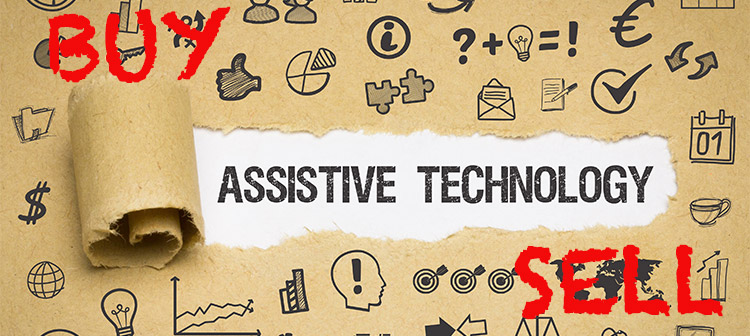
Can I buy second hand disability equipment with my NDIS funds?
Buying second-hand assistive technology can help spread your NDIS funds that little bit further or perhaps you are even looking to sell assistive technology that you no longer need.
Below find a collection of options where you are able to buy or sell disability equipment.
There are a number of Facebook groups that help people sell, swap and buy second-hand disability equipment:
- Second-hand equipment for children with disability in Australia
- Disability Equipment Australia for Sale or Swap
- Buy and Sell Disability Products Australia - new and used
- Disability and Special Needs Equipment Australia - Buy, Sell Swap or Free
The following Assistive Technology websites also offer the ability to buy or sell second-hand equipment:
- ebility - buy and sell
- Mobile Independence
- TAD Equip Second Hand Equipment
- Trading Post - Mobility Aids
General Trading Websites:
If you are self-managed or plan managed, you can use your NDIS funds to buy second-hand equipment so long as:
- You can answer YES to the "Can I buy it with my NDIS funding?" - see our resource titled "What can I buy with my NDIS funding?"
- You have a receipt and the details of the transaction. If the transaction is made in person, type up the receipt with the sellers details, date, item description and cost and have the seller sign it. If the transaction was made online, keep a copy of the emaill or even a screen shot of the transaction.
Tips for buying Second Hand Assistive Technology Disability Equipment
Buying second-hand disability assistive technology (AT) can save money, but it's crucial to ensure safety, suitability, and functionality. Here’s a comprehensive guide to help you buy wisely:
1. Know What You Need
Before buying, make sure you know:
- Specific features required (e.g., seat width for a wheelchair, lift capacity for a hoist).
- Whether the item needs to be prescribed by an OT or allied health professional (especially for NDIS funding), like a wheelchair.
- Whether the person using it has changing needs (e.g., progressive conditions).
- Tip: If unsure, consult an occupational therapist (OT) to assess suitability.
2. Inspect for Condition and Safety
Ask or check for:
- Signs of wear or damage: rust, frayed cables, cracked parts.
- Functionality: all buttons, motors, or mechanisms should work properly.
- Cleanliness: especially for hygiene-related items (toilet/shower chairs).
- Battery health (for powered devices): check runtime or if it holds charge.
- Weight limit & dimensions: must match user needsp If possible, test it in person or ask for a video demo before buying online.
3. Ask About Service History
- Has it been regularly maintained or repaired?
- Any manuals or accessories included?
- If powered: has the battery/motor ever been replaced?
- How old is the item?
- Tip: Avoid equipment that's older than 5–7 years, unless it’s well-maintained and simple (like walkers or rails).
4. Check for Compatibility
- Make sure it fits your environment:
- Will it fit through doorways or around tight corners?
- Is it compatible with other equipment (e.g., a lift chair with a specific hoist)?
- Can it be transported/stored easily?
5. Check Warranty, Insurance & Return Policy
Most second-hand items are sold “as-is”, but some suppliers offer limited warranties.
If you're buying from a business (not an individual), ask about:
- Return/refund policy
- Short-term warranty
- Insurance for delivery
6. Compare Prices
Look at similar listings on platforms like eBility, Gumtree, or AT Australia.
Prices can vary a lot, so ensure you're paying a fair amount relative to condition and age.
7. Check NDIS Rules (if relevant)
If you're self- or plan-managing through the NDIS:
You can buy second-hand AT if it’s considered low-cost (under $1,500) or mid-cost (under $15,000).
You’ll need:
- A receipt or invoice (must include item details, seller info, date, and amount).
- Confirmation the item is safe and appropriate (usually via an OT or therapist note).
- Keep all documentation for audits or plan reviews.
8. Involve a Health Professional
Always a good idea if:
- The item is for a complex physical condition.
- You’re buying something electronic or medical (e.g. CPAP machines, power chairs, hoists).
- You’re unsure about fit, comfort, or ongoing suitability.
9. Sanitise and Maintain After Purchase
- Clean thoroughly before first use.
- Check bolts, screws, and brakes regularly.
- Replace worn-out accessories (e.g., cushions, pads, straps).
10. Make sure you have the documentation you need
Self managed and Plan managed participants need to make sure they get a receipt with:
- seller details
- item description
- price
- proof of payment - copy of the item in your bank statement to show you have paid for it - a plan manager cannot reimburse you without this
Here is a buying checklist for you
- Check functionality and safety
- Confirm size and weight capacity
- Ask about usage history and age
- Get proper documentation
- Make sure you have receipt of your payment
- Involve a therapist for complex needs like wheelchairs
- Compare similar items to assess value
- Clean and inspect thoroughly before use
- Proof of payment: make sure you have a receipt that shows the details of the sale or the payment made from your bank. If purchased from a business, an invoice is required too.
Sources:
NDIS THERAPY FINDER - FREE SERVICE
LET US FIND YOU A SKILLED SUPPORT WORKER

